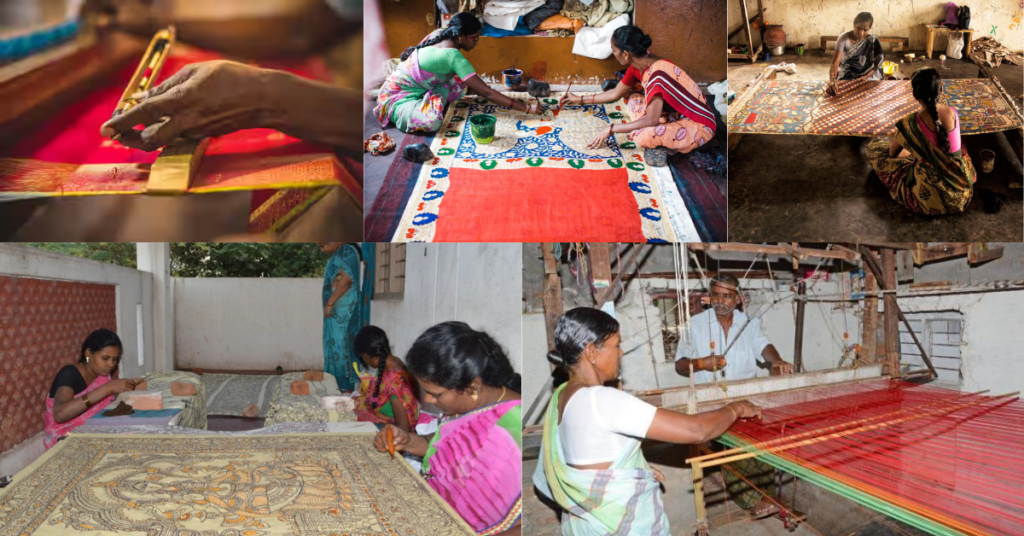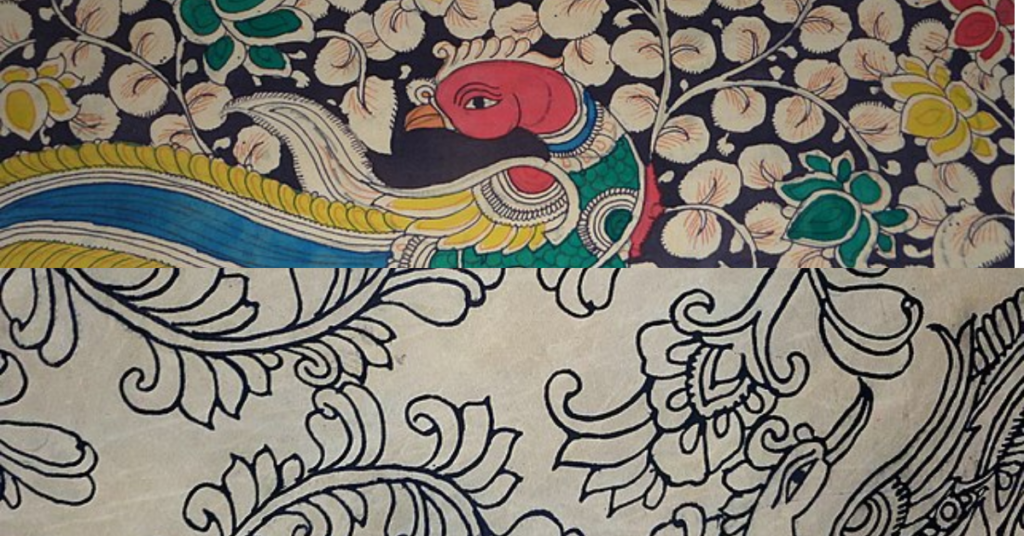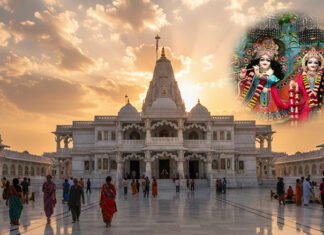Have you ever wondered about the intricate artistry behind those stunning silk sarees that catch your eye? 🧵✨ Prepare to be mesmerized as we embark on a journey into the enchanting world of Srikalahasti Silk Saree Weaving Units. This ancient craft, steeped in rich heritage and tradition, has been transforming mere threads into treasured works of art for generations.
Imagine running your fingers over the smooth, lustrous fabric of a Srikalahasti silk saree, feeling the weight of centuries of craftsmanship. From the moment the first thread is spun to the final intricate design, every step in creating these masterpieces is infused with magic and meticulous skill. But as modern trends threaten to overshadow traditional crafts, the question arises: how can we preserve this timeless art form for future generations?
Join us on a journey through the weaving units of Srikalahasti, where each thread tells a story of dedication, artistry, and heritage.
Join us as we unravel the journey of Srikalahasti silk sarees, from their historical roots to their contemporary global appeal.
The Rich Heritage of Srikalahasti Silk
Origins and Historical Significance
The origins of Srikalahasti silk sarees trace back to the Vijayanagara Empire when rulers and aristocrats adorned themselves in these rich fabrics for temple rituals and royal ceremonies. Over time, the craft flourished under various dynasties, eventually making Srikalahasti a vital weaving hub in South India.
Unique Characteristics of Srikalahasti Silk
Srikalahasti silk is distinguished by:
- Temple-Inspired Borders – Reflecting the intricate carvings of Srikalahasteeswara Temple.
- Pure Mulberry Silk – Offering a luxurious texture and unmatched durability.
- Rich Zari Work – Gold and silver threads add grandeur.
- Handwoven Craftsmanship – Every saree is manually woven, making it unique.
Cultural Importance in Indian Textile Tradition
Srikalahasti silk sarees are deeply intertwined with Indian customs and traditions. From being a preferred choice for bridal trousseaus to serving as sacred offerings in temples, these sarees symbolize purity, prosperity, and devotion.
ALSO READ: Dharmavaram Travel Guide: The Silk City of Andhra Pradesh
Understanding the Srikalahasti Silk Weaving Process
Raw Materials and Their Sourcing
The primary raw material, mulberry silk, is sourced from Karnataka and Tamil Nadu, ensuring the finest quality. The zari (gold and silver threads) comes from Surat, Gujarat.
Traditional Techniques and Tools
Artisans employ pit looms and frame looms, using techniques passed down through generations. Each saree takes weeks or even months to complete, depending on its complexity.
Step-by-Step Weaving Procedure
- Silk Thread Processing – Raw silk is boiled, dyed, and spun.
- Warping and Wefting – Threads are arranged on the loom.
- Hand Weaving – Patterns are intricately woven using jacquard techniques.
- Zari Embellishment – Gold and silver threads enhance the saree’s beauty.
- Finishing and Polishing – The saree undergoes a final check before being packed.
Modern Innovations in Silk Production
With rising demand, weavers are not only incorporating computer-aided designs but also using chemical-free dyes to cater to contemporary tastes while still retaining traditional elements.
Exploring Srikalahasti Silk Weaving Units
Layout and Organization of Weaving Centers
Srikalahasti’s weaving clusters accommodate multiple artisans, with each artisan specializing in dyeing, weaving, or embroidery.
Meet the Skilled Artisans
The craft is a family tradition, with skills passed down from generation to generation. Conversations with artisans reveal their dedication, patience, and passion for weaving.
Daily Life in a Weaving Unit
A typical day begins at sunrise, with artisans setting up their looms, preparing the threads, and weaving meticulously for hours. Women often assist in finishing touches and embroidery.
Challenges Faced by Weavers
- Low Wages – Despite their skill, many weavers struggle financially.
- Competition from Power Looms – Mass production threatens traditional handlooms.
- Limited Recognition – Many artisans lack direct access to large markets.
The Artistry of Srikalahasti Saree Designs
Iconic Motifs and Patterns
Designs often draw inspiration from temple sculptures, peacocks, mango motifs, and floral patterns.
Color Palettes and Their Significance
Traditional colors include deep reds, vibrant blues, emerald greens, and royal purples, often symbolizing prosperity and spirituality.
Customization Options for Buyers
Many artisans offer bespoke designs, allowing buyers to personalize borders, motifs, and colors.
Blending Tradition with Contemporary Trends
Modern variations include lighter sarees with pastel hues and fusion designs, catering to younger audiences while retaining the essence of tradition.
ALSO READ: Srikalahasti Temple History, Significance & Travel Guide
From Loom to Wardrobe: The Journey of a Saree
Quality Control Measures
Each saree undergoes rigorous checks for texture, weave strength, and design accuracy.
Finishing Touches and Embellishments
Additional zari work, embroidery, and polishing enhance the final look.
Packaging and Distribution
Artisans carefully fold sarees, wrap them in muslin cloth, and package them for sale in local and international markets.
Caring for Your Srikalahasti Silk Saree
- Dry clean only to maintain the silk’s sheen.
- Wrap in muslin and store in a cool, dry location.
- Avoid direct sunlight to prevent fading.
Supporting the Srikalahasti Silk Industry
Eco-Friendly Practices in Silk Production
Many weaving units have adopted natural dyes and organic silk production to reduce environmental impact.
Fair Trade Initiatives for Weavers
Organizations and NGOs promote ethical sourcing and better wages for artisans.
Government Schemes and Support
- Handloom Development Programs – Financial aid and training.
- Silk Mark Certification – Ensures authenticity and boosts sales.
How Consumers Can Contribute to Sustainability
By purchasing handwoven sarees directly from weavers or certified stores, buyers support artisans and help preserve this heritage.
The Global Appeal of Srikalahasti Silk
International Recognition and Awards
Srikalahasti silk has received accolades at global textile exhibitions and is gaining prominence in international markets.
Export Markets and Demand
Countries like the USA, UK, and Singapore have a growing demand for handcrafted Indian silk sarees.
Srikalahasti Silk in High Fashion
Renowned designers incorporate Srikalahasti silk into fusion wear and contemporary couture.
Preserving the Art for Future Generations
Encouraging young weavers, government initiatives, and digital marketing are key to keeping the craft alive.
Srikalahasti Silk Saree Gallery





Visiting the Srikalahasti Silk Weaving Units
A visit to Srikalahasti is incomplete without exploring its silk-weaving units. These small workshops, often run by families, offer a firsthand experience of the saree-making process. Tourists can witness artisans at work and even purchase sarees directly from the weavers.
Best Places to Visit
- Local Handloom Cooperative Societies – Ideal for purchasing authentic silk sarees at fair prices.
- Traditional Weaving Villages – Explore areas where artisans continue to weave sarees using age-old techniques.
- Government Emporiums – A great place to buy certified Srikalahasti silk sarees.
Must-Buy Silk Products
Besides sarees, visitors can also find silk dupattas, dress materials, and stoles made using the same traditional techniques. These make for beautiful souvenirs and gifts.
Must-Have Travel Products for Srikalahasti Visit
🎒 Comfortable Footwear – You’ll walk a lot in weaving units and temples
👗 Light Cotton Clothes – Srikalahasti can be humid
📷 Camera – To capture the artistry of weaving
🛍️ Spacious Bag – For carrying saree purchases
💧 Reusable Water Bottle – Stay hydrated
For the Best Deals for Flights And Hotel Click here
Final Thoughts: A Timeless Weave of Tradition & Elegance
Srikalahasti silk sarees are not just garments; they are stories woven in silk. From their sacred origins to their modern evolution, these sarees carry the legacy of India’s finest craftsmanship.
So, next time you drape a Srikalahasti silk saree, remember—you are wearing a piece of history, woven with devotion and artistry.
Have you ever worn or purchased a Srikalahasti silk saree? Share your experience in the comments below!ce.
For more travel guides and tips, visit TravellerKaka.com. Happy travels!
Frequently Asked Questions
Srikalahasti silk sarees are renowned for their pure silk fabric, intricate zari work, and vibrant colors. They are entirely handwoven, making each saree a unique piece of art.
The best time to visit Srikalahasti for shopping and sightseeing is between October and March when the weather is pleasant.
A single Srikalahasti silk saree can take anywhere from 15 days to 3 months, depending on the complexity of the design and the craftsmanship involved.











